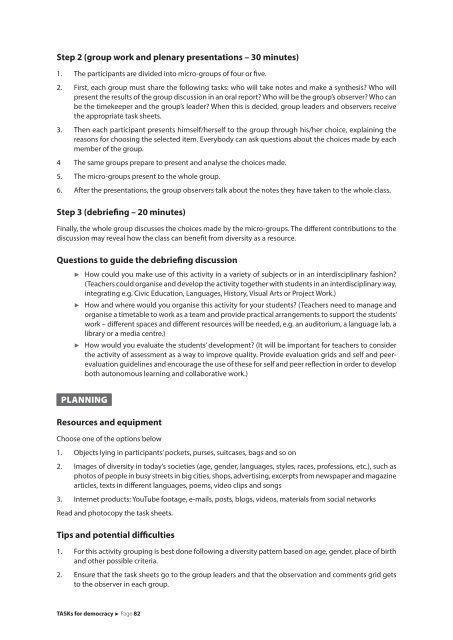TASKs for democracy
4NYw4W
4NYw4W
Create successful ePaper yourself
Turn your PDF publications into a flip-book with our unique Google optimized e-Paper software.
Step 2 (group work and plenary presentations – 30 minutes)<br />
1. The participants are divided into micro-groups of four or five.<br />
2. First, each group must share the following tasks: who will take notes and make a synthesis? Who will<br />
present the results of the group discussion in an oral report? Who will be the group’s observer? Who can<br />
be the timekeeper and the group’s leader? When this is decided, group leaders and observers receive<br />
the appropriate task sheets.<br />
3. Then each participant presents himself/herself to the group through his/her choice, explaining the<br />
reasons <strong>for</strong> choosing the selected item. Everybody can ask questions about the choices made by each<br />
member of the group.<br />
4 The same groups prepare to present and analyse the choices made.<br />
5. The micro-groups present to the whole group.<br />
6. After the presentations, the group observers talk about the notes they have taken to the whole class.<br />
Step 3 (debriefing – 20 minutes)<br />
Finally, the whole group discusses the choices made by the micro-groups. The different contributions to the<br />
discussion may reveal how the class can benefit from diversity as a resource.<br />
Questions to guide the debriefing discussion<br />
<br />
<br />
<br />
How could you make use of this activity in a variety of subjects or in an interdisciplinary fashion?<br />
(Teachers could organise and develop the activity together with students in an interdisciplinary way,<br />
integrating e.g. Civic Education, Languages, History, Visual Arts or Project Work.)<br />
How and where would you organise this activity <strong>for</strong> your students? (Teachers need to manage and<br />
organise a timetable to work as a team and provide practical arrangements to support the students’<br />
work – different spaces and different resources will be needed, e.g. an auditorium, a language lab, a<br />
library or a media centre.)<br />
How would you evaluate the students’ development? (It will be important <strong>for</strong> teachers to consider<br />
the activity of assessment as a way to improve quality. Provide evaluation grids and self and peerevaluation<br />
guidelines and encourage the use of these <strong>for</strong> self and peer reflection in order to develop<br />
both autonomous learning and collaborative work.)<br />
PLANNING<br />
Resources and equipment<br />
Choose one of the options below<br />
1. Objects lying in participants’ pockets, purses, suitcases, bags and so on<br />
2. Images of diversity in today’s societies (age, gender, languages, styles, races, professions, etc.), such as<br />
photos of people in busy streets in big cities, shops, advertising, excerpts from newspaper and magazine<br />
articles, texts in different languages, poems, video clips and songs<br />
3. Internet products: YouTube footage, e-mails, posts, blogs, videos, materials from social networks<br />
Read and photocopy the task sheets.<br />
Tips and potential difficulties<br />
1. For this activity grouping is best done following a diversity pattern based on age, gender, place of birth<br />
and other possible criteria.<br />
2. Ensure that the task sheets go to the group leaders and that the observation and comments grid gets<br />
to the observer in each group.<br />
<strong>TASKs</strong> <strong>for</strong> <strong>democracy</strong> Page 82


